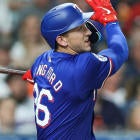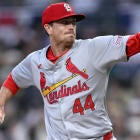
The trade deadline is barely behind us, and many of the involved players still have yet to slip into their new uniforms. But already, we can tell who the big winners and losers are, right?
Well, I can, and I'm here to point them out to you.
If you prefer less of a curated list than a full rundown of the trades and Fantasy implications thereof, we have you covered there, too. Be sure to check out our Trade Deadline Tracker with real-time reactions from Chris Towers and myself.
In contrast, this article is my attempt to boil that massive document down to its most essential parts. The way I see it, 12 players' Fantasy stock was greatly impacted by the deadline, including seven for the better and five for the worse.
Stock up
A reliever's value is so closely tied to his saves output in traditional scoring formats that closer changes always make for the biggest winners and losers at the deadline. We've long assumed Williams would be a stud closer whenever the Brewers moved on from Josh Hader, his Airbender changeup (as nicknamed by Pitching Ninja of Twitter fame) having made him a bullpen ace three years running. The one complicating factor is that the Brewers got Taylor Rogers back in the Hader deal, which could make for a righty-lefty platoon at the end of games. Then again, the Padres had recently backed Rogers off the ninth-inning role because of a poor July, which should give Williams an early leg up.
| ||||||||||||
About the only thing more surprising than Jorge Lopez's emergence as a lockdown closer is that 27-year-old rookie Felix Bautista has been arguably even better. It makes him the obvious choice to replace Lopez, who's now with the Twins, and fortunately, manager Brandon Hyde sees it the same way. "I think Bautista, when he's out there in the eighth inning or ninth inning at times, he has shown [the mentality]," Hyde said. "I think he's going to get a shot." Hyde did allow for left-hander Cionel Perez getting chances as matchups warrant, which is a little disconcerting given how inconsistent the Orioles' save chances are, but rarely do rebuilding clubs have such a clear succession plan for the ninth inning.
| ||||||||||||
We all know Great American Ball Park is a tough place to pitch. We all know it's especially tough for a fly-ball pitcher like Mahle. But we may not appreciate just how tough it's been for him specifically. After all, he had a breakout season for the Reds last year and has been money since late May this year. For his career, though, he has a 5.02 ERA at home compared to 3.74 on the road. The difference in HR/9 is even starker: 1.9 at home vs. 0.8 on the road. A move to a more neutral, slightly pitcher-leaning venue like Target Field could be completely transformative for Mahle, making him potentially a top-30 starting pitcher the rest of the way.
| ||||||||||||
Mancini said it himself in his introductory press conference with the Astros Tuesday. "Left field here probably suits me better on both sides of the ball." It's the offensive side that we care about most. The park shift wouldn't be so extreme if the Orioles hadn't dramatically altered their left field dimensions prior to this season, making them among the most imposing for power hitters. The Astros of course have the Crawford Boxes in left field, so we're talking a difference of several dozen feet for that stretch of outfield fence. According to Statcast, Mancini would have 22 home runs if he had played every game at Minute Maid Park this year as opposed to the 10 he actually has.
| ||||||||||||
Montas hasn't performed any worse this year than he did last year, really. The reason he's been less impactful for Fantasy, ranking right around the 50th starting pitcher in both scoring formats, is because of his 4-9 record, a product of pitching for the worst team in the AL. If he had been with the Yankees, the best team in the AL, from the beginning, he might be 9-4 or better, which would completely change the complexion of his season so far. Some have suggested he'll struggle with the smaller venue, given his 5.01 ERA on the road this year, but being more of a ground-ball pitcher, he isn't as susceptible to venue. His home/away splits were basically even in his last two full seasons, 2019 and 2021.
| ||||||||||||
Castillo's stock improves just by going from a non-contender to a contender. The Reds had provided him only four wins in 14 mostly excellent starts. He also goes from one of the hitter-friendliest parks to one of the pitcher-friendliest, though it isn't as significant for a ground ball-generator like him as it is for Tyler Mahle. It's not nothing, though. Castillo has leaned more on his four-seamer this year at the expense of his sinker, and it's made him less of an outlier for ground balls than usual. Fittingly, he has a 3.64 ERA at home compared to 2.09 on the road.
| ||||||||||||
The Royals finally moved on from their longtime second baseman, Whit Merrifield, at the deadline, and we already have a pretty good idea who the next man up is based on what happened when Merrifield was unavailable for a Toronto series a couple weeks ago. Back then, the Royals called up Massey, and sure enough, the 24-year-old was scratched from Triple-A Omaha's lineup Monday. We'll learn soon enough if it's a precursor to his promotion, but all he's done the past two years in the minors is mash. His career took a little while to get off the ground because of a back issue, which I think is why he hasn't gotten more attention as a prospect, but I expect him to find success in the majors.
| ||||||||||||
Stock down
In what was the final (and probably weirdest) trade of this deadline period, the Angels shipped their closer to the Braves, who already spent big for closer Kenley Jansen this offseason. They seem happy with what Jansen has done for them in the role, so I don't envision any sort of timeshare developing. Iglesias also has some work to do to get his ERA under 4.00, not that the underlying numbers reveal any cause for concern. Mostly, I think the Braves wanted to secure their future closer, Iglesias being already signed for the next three years, but if he's not getting saves right now, he no longer has much appeal in traditional scoring formats.
| ||||||||||||
At first, I thought Seranthony Dominguez was the big loser here seeing as the Phillies hadn't fully embraced him as the closer yet. The more experienced Robertson had done a good enough job with the Cubs, I thought. But according to MLB.com writer Todd Zolecki, manager Rob Thomson said Dominguez and Brad Hand will continue to work the eighth and ninth innings, the implication being that Robertson won't. Things could change, of course, but for as good as Robertson has been this year, Dominguez has been even better. He remains the preferred choice over Hand, too, if for no other reason than he throws right-handed. (Update: Robertson got the save on his first day with his new club Wednesday, so who knows anymore?)
| ||||||||||||
When Blue Jays manager John Schneider was singing the praises of his team's latest acquisition, he described him as "someone who gives you a little bit more insurance." That's not how we think of Merrifield in Fantasy at all. He's been a mainstay for the past six years, and while his numbers are lagging this year, they've come around since about mid-May, giving him a .280 batting average in his past 68 games. Still, he has a negative WAR on the year, and the Blue Jays' incumbent second baseman, uninspiring though Santiago Espinal may be, was indeed an All-Star. I still suspect Merrifield will play a lot between the infield and outfield, but his stud status in Fantasy was always tied to volume, to him playing literally every day. He might be just a middling steals specialist now.
| ||||||||||||
Drury has been one of the more surprising breakout bats of this season, and a closer inspection reveals that it's probably venue-aided. True, he's barreling up the better this year (like, literally a higher barrel rate), but he's batting .298 with a .915 OPS at home compared to .241 with a .771 OPS on the road. Great American Ball Park has long been considered one of the most favorable for home runs, and over the last three years, it's been a distant No. 1, with upward of 50 percent more home runs being hit there than ... well, Petco Park, for instance. It's also possible Drury sits more often with the Padres given that he'll be playing more of a super utility role.
| ||||||||||||
Truth is Syndergaard's stock was bound to tumble anyway. His move from a pitcher's park in Anaheim to a hitter's park in Philadelphia will only exacerbate the problem. A 3-mph velocity drop has tanked his strikeout rate, and when you consider his 4.27 xFIP and 4.25 xERA, it's a wonder his ERA is as low as 3.83. The big home park that he's now leaving probably helped. He has a 2.96 ERA there compared to 5.17 everywhere else. But again, I would have been betting big on regression even if Syndergaard had stuck around.
| ||||||||||||








































